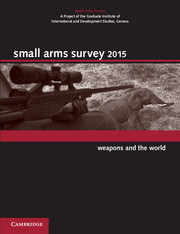Book contents
- Frontmatter
- FOREWORD
- Contents
- ABOUT THE SMALL ARMS SURVEY
- Notes to readers
- ACKNOWLEDGEMENTS
- Introduction
- Chapter 1 In the Line of Fire: Elephant and Rhino Poaching in Africa pages 6 to 19
- Chapter 1 In the Line of Fire: Elephant and Rhino Poaching in Africa pages 20 to 35
- Chapter 2 Digging for Trouble: Violence and Frontier Urbanization
- Chapter 3 One Meeting after Another: UN Process Update
- Chapter 4 Trade Update: After the ‘Arab Spring’ pages 84 to 91
- Chapter 4 Trade Update: After the ‘Arab Spring’ pages 92 to 123
- Chapter 5 Less ‘Bang’ for the Buck: Stockpile Management in South-east Europe
- Chapter 6 Expanding Arsenals: Insurgent Arms in Northern Mali pages 156 to 169
- Chapter 6 Expanding Arsenals: Insurgent Arms in Northern Mali pages 170 to 185
- Chapter 7 Waning Cohesion: The Rise and Fall of the FDLR–FOCA pages 186 to 198
- Chapter 7 Waning Cohesion: The Rise and Fall of the FDLR–FOCA pages 199 to 215
- Chapter 8 Stockpiles at Sea: Floating Armouries in the Indian Ocean
- Chapter 9 Unprotected: Young People in Post-conflict Burundi pages 242 to 249
- Chapter 9 Unprotected: Young People in Post-conflict Burundi pages 250 to 267
- INDEX
FOREWORD
Published online by Cambridge University Press: 05 July 2015
- Frontmatter
- FOREWORD
- Contents
- ABOUT THE SMALL ARMS SURVEY
- Notes to readers
- ACKNOWLEDGEMENTS
- Introduction
- Chapter 1 In the Line of Fire: Elephant and Rhino Poaching in Africa pages 6 to 19
- Chapter 1 In the Line of Fire: Elephant and Rhino Poaching in Africa pages 20 to 35
- Chapter 2 Digging for Trouble: Violence and Frontier Urbanization
- Chapter 3 One Meeting after Another: UN Process Update
- Chapter 4 Trade Update: After the ‘Arab Spring’ pages 84 to 91
- Chapter 4 Trade Update: After the ‘Arab Spring’ pages 92 to 123
- Chapter 5 Less ‘Bang’ for the Buck: Stockpile Management in South-east Europe
- Chapter 6 Expanding Arsenals: Insurgent Arms in Northern Mali pages 156 to 169
- Chapter 6 Expanding Arsenals: Insurgent Arms in Northern Mali pages 170 to 185
- Chapter 7 Waning Cohesion: The Rise and Fall of the FDLR–FOCA pages 186 to 198
- Chapter 7 Waning Cohesion: The Rise and Fall of the FDLR–FOCA pages 199 to 215
- Chapter 8 Stockpiles at Sea: Floating Armouries in the Indian Ocean
- Chapter 9 Unprotected: Young People in Post-conflict Burundi pages 242 to 249
- Chapter 9 Unprotected: Young People in Post-conflict Burundi pages 250 to 267
- INDEX
Summary
Today's wildlife crime threatens the survival of endangered and vulnerable species in many African countries. Evidence documented by WildlifeDirect—a Kenyan NGO founded in 2004—shows that legal penalties designed to deter such crimes have had little impact on poachers and traffickers; worse, poor law enforcement and corruption among government officials and security forces facilitate wildlife crime and trafficking.
In a chapter on the poaching of elephants and rhinos, the Small Arms Survey 2015: Weapons and the World offers valuable analysis of the relative roles of different actors, including non-state armed groups, criminal networks, and commercial poachers, in wildlife crime. The research reveals that while poachers are becoming increasingly militarized, law enforcement units have yet to adopt a systematic approach to recording and tracing firearms and ammunition found at poaching sites—steps that increase the likelihood of identifying poachers, the sources of their guns, and broader trafficking networks. These findings are especially valuable to broader efforts to tackle the illegal killing of wildlife.
The volume's chapter on armed violence around resource extraction sites is also pertinent to our work. As the Survey observes, the establishment of mining sites tends to be accompanied by the rapid urbanization of adjacent communities, growing inequalities, and shortfalls in service delivery—all of which attract a variety of armed actors and increase the pressure on natural habitats and wildlife.
I commend the Small Arms Survey 2015: Weapons and the World for the many insights it offers into the relationship between firearms and wildlife crime, as well as other pertinent small arms issues. I have little doubt that this volume will be of great interest to those working to protect our natural heritage, as well as others involved in arms control and the promotion of peace and security.
- Type
- Chapter
- Information
- Small Arms Survey 2015Weapons and the World, pp. iiiPublisher: Cambridge University PressPrint publication year: 2015



